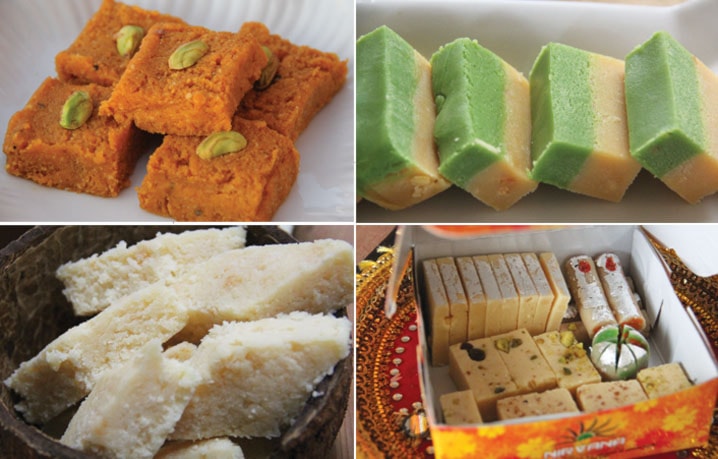On Nov. 3, Hindus will celebrate one of their biggest religious holiday, Diwali, better known as the festival of lights.
In India, this day is marked with bright lights, lighting of firecrackers, gift exchanges and a lot of sweets. The main sweet of the festivities is barfi, a sweet confection that because of its texture and appearance could be a close kin to fudge.
Eaten and served in bite-sized pieces, barfi is a very popular sweet in India. Just like bringing a bottle of fine wine when you visit someone for the first time, a decorative box filled with different kinds of barfi is a traditional present taken as a hostess gift.
Because barfi is very closely associated with many Indian festivals, it is quite common to see Indian sweet shops both in India and here overflowing with a huge varieties of them during many Indian celebrations.
Barfi also plays an important role in worship and is offered to deities in temples, where it is called prashad. Similarly, it is quite common to include it in the plate of food that is first offered Laxmi — goddess of wealth, during the Diwali prayer.
Although you can purchase barfi at Indian sweet shop in Edmonton and Calgary, there are some traditionalists who still stick to the old ritual of making it at home during Diwali. My mom is one of those people. Growing up, the build-up to Diwali began when my mom started making her barfi.
“If you are offering it to the gods, then you have to ensure that it is pure and made with clean hands and soul,” was the rationale my mom used to explain why she made barfi in the kitchen instead of buying from the store. I am glad she did because, like many things, the taste of store bought cannot rival the homemade.
Every barfi maker has their own versions of the recipe. Traditionally, barfi was made with milk that was cooked slowly until the liquid was reduced to a fudge-like consistency. This milk solid was then flavoured with either saffron, vanilla essence, cardamom or rose water. Depending on type of barfi being prepared, cashews, almonds, pistachios or fresh coconut were added.
The tedious part of barfi making was patiently waiting for the liquid milk to be reduced to soft, doughy mass. For this, the milk was cooked on medium heat and continually mixed to prevent the milk from burning; definitely not a job for the weak shouldered or the impatient cook.
Waiting for the milk reduction alone was enough to deter some enthusiast from taking on the task of making barfi at home.
Fortunately, the modernists have replaced the tedious task with similar textured and flavoured substitutes like paneer (Indian cheese), ricotta cheese, sweetened condensed milk or dry milk powder. By using one or combination of these, even the purist have a hard time distinguishing the milk reduction mass from its substitution.
Like fudge, barfi comes in different varieties. Although plain, coconut and nut varieties have stood the test of time, there are selections of new flavours making waves. Pumpkin, mango and chocolate-based barfi, although traditionally not popular, are fast gaining more lovers.
Unlike fudge, which is typically cut into small squares, barfi can come in log, diamond or even flower shapes. These pieces are sometimes decorated with edible silver foil, different colours or simply with nuts.
I am including my mom’s barfi recipe that she has prepared for over 30 years and some others that are my favourites.
MOM’S MILK BARFI
1 cup unsalted butter
500 ml Ricotta cheese
1 1/2 cup sugar
5 1/2 cups skim milk
250 ml whipping cream
1 teaspoon ground cardamom
Food colouring (optional)
Line nine-by-nine-inch pan with parchment paper. Blend cheese in blender. Melt butter in frying pan over medium heat. Add sugar and milk. Mix. Cook and slowly add whipping cream. Continue to mix and cook until mixture becomes a dough consistency. Will take about 45 minutes. Add cardamom powder. Divide into two portions. Colour desired colour into one. Pour half into pan. Level. Pour the second layer.
COCONUT BARFI
1 tsp butter
2 cups whole-milk ricotta
1 heaping cup of granulated sugar
1 pound unsweetened coconut
Line a nine-by-13-inch pan with parchment paper and set aside. In a medium, shallow pan over medium heat, melt butter. Combine in ricotta and sugar, and stir until melted. Reduce heat to very low and add in coconut. Stir until coconut absorbs all the liquid, 15 to 30 minutes. Be sure to stir frequently to prevent coconut from burning. The coconut mixture should firming up. Once all the liquid has been absorbed and coconut has had time to cook some, pour into pan. Press evenly across the pan and flatten out with the back of a spatula. Leave burfi out to cool to set and cut into small diamonds and serve.
PUMPKIN BARFI
1 cup canned pumpkin
1 cup ricotta cheese
1 cup sugar
1 teaspoons green cardamom powder
1/4 cup butter
Line nine-by-nine-inch pan with parchment paper. Mix ricotta cheese and green cardamom powder with the pumpkin paste. Blend well in a blender. Heat butter in a pan; add the mixture and cook, stirring constantly, until it turns sticky and almost dry — it should have a dry binding consistency.
Pour the hot mixture and spread it evenly with the help of a spatula. This needs to be done while the mixture is hot (else it will not take our desired shape). Now cut the spread mix into small pieces of your choice. Once it cools down, it will harden further. Serve.
Madhu Badoni is a Red Deer-based freelance food writer. She can be reached at madhubadoni@gmail.com or on Twitter @madhubadoni. Watch for Madhu’s Masala-Mix blog on www.reddeeradvocate.com.
